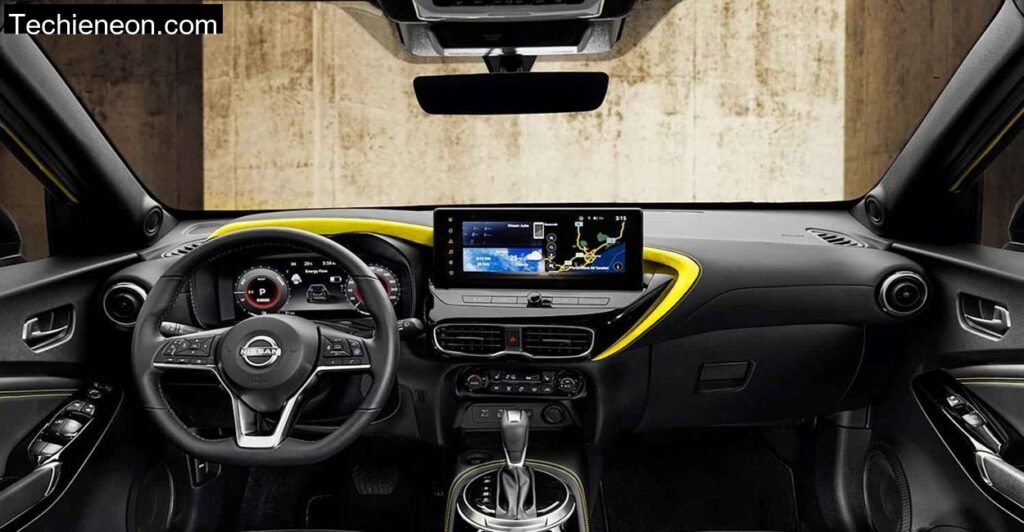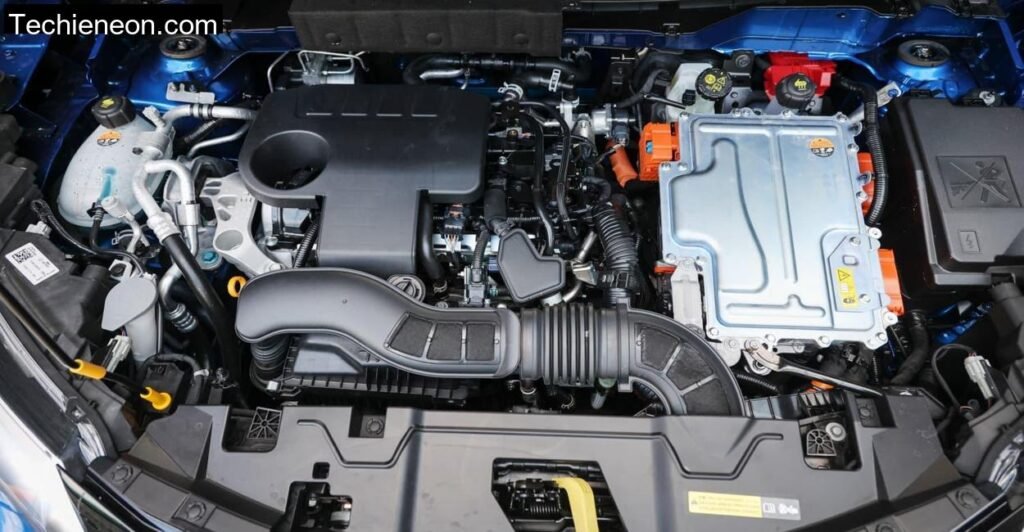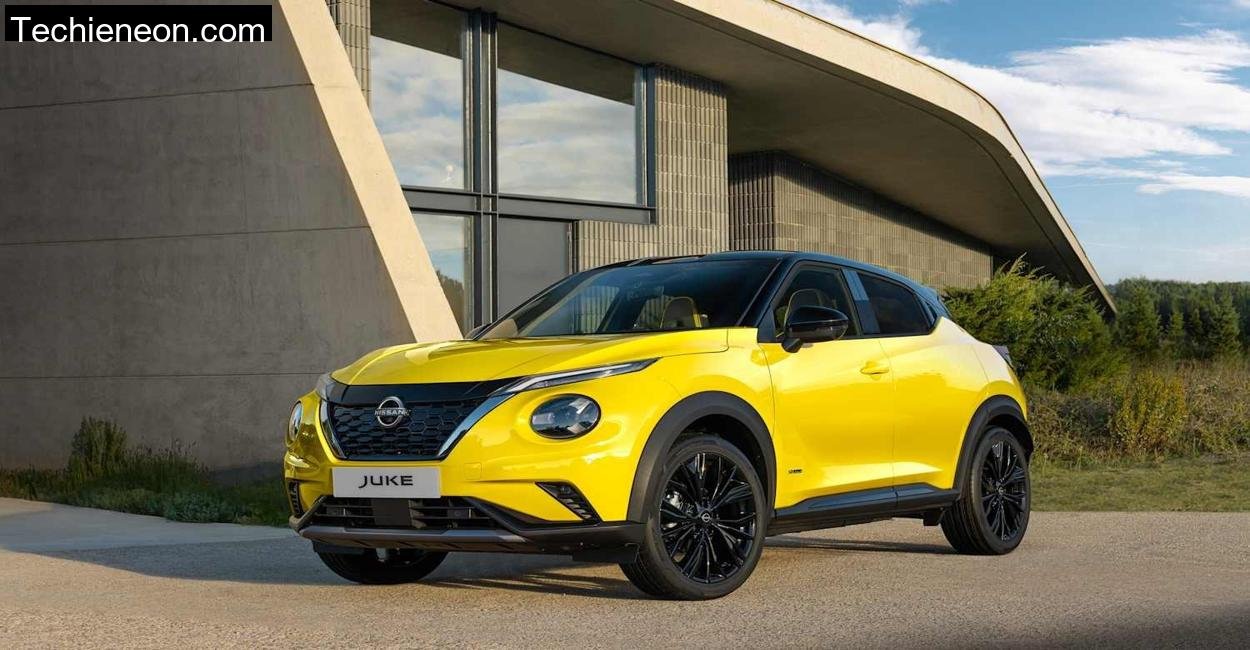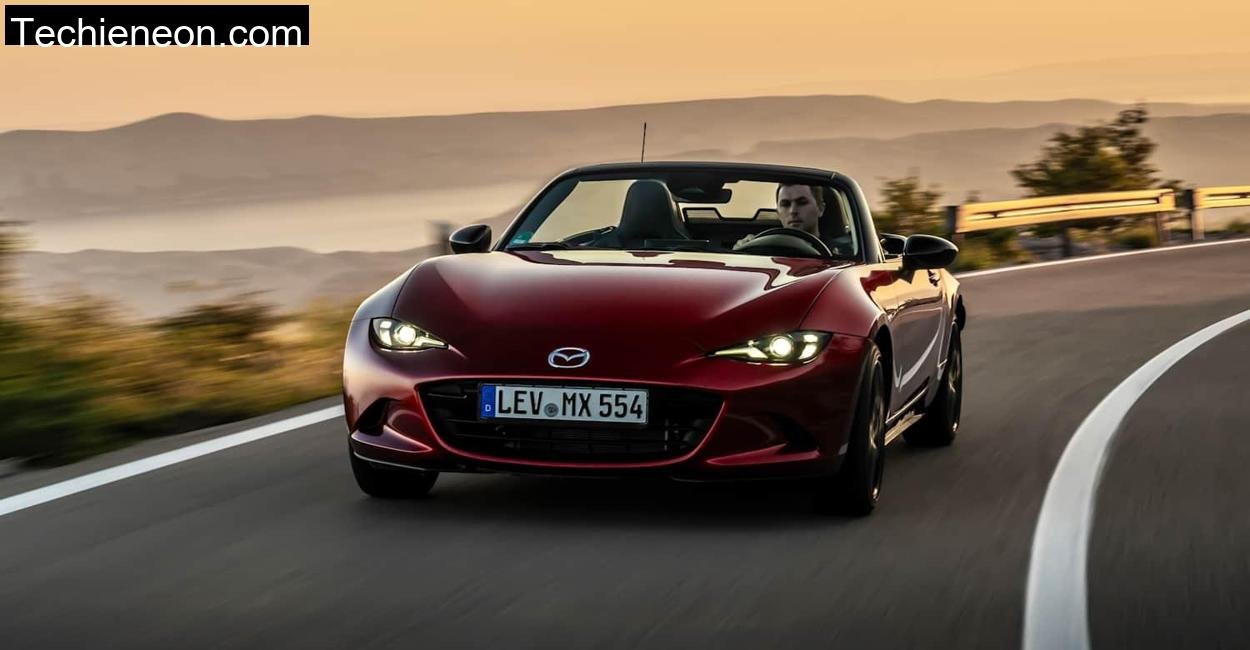Juke motto: Design is everything!
The Juke is a statement piece, plain and simple. It always has been. Nissan’s designers knew it wouldn’t be for everyone, and they embraced it. Even in this second generation, the Juke doesn’t blend in. At the front, those iconic round headlights still sit below narrow slits of DRLs, while the V-motion grille with its honeycomb detail cuts sharply through the air. The yellow paint on my test car shimmered oddly against the Högl’s moody skies, adding to its alien appeal.
From the side, the Juke’s coupe-SUV silhouette remains as distinctive as ever. The blacked-out C-pillars create a floating roof effect, and those hidden rear door handles still make you pause for a second. It’s aggressive, playful, and weird in all the right ways. This car doesn’t chase trends, it creates its own.
But there’s a price to pay for that style.
Poor all-round visibility in the Juke
Design over function? That’s the Juke’s Achilles’ heel, and it’s most obvious when navigating narrow country roads or reversing down gravel driveways. The thick C-pillars and tiny rear window limit visibility so much that without tech help, parking in Berchtesgaden’s tight market square would’ve been a gamble.
Thankfully, the N-Connecta trim I drove came with front and rear parking sensors and a decent rearview camera. I ticked the optional 360-degree camera box, too, and honestly, it’s almost essential. Still, it lacks a self-parking system, which many rivals now offer. Driving in fog near the Saalach river, I wished for rear cross-traffic alert more than once. You adapt, but you never fully relax.
Nissan Juke has more space than before
Step inside and the improvement over the previous generation is clear. The 2024 Juke now stretches to 4.21 meters, and while that doesn’t sound like much, it’s made a world of difference in the cabin. The rear bench is no longer the claustrophobic punishment it once was. With the wheelbase extended by 10 cm, there’s finally enough knee and headroom for adults, at least for short alpine drives to Bad Reichenhall.
The boot, while still not class-leading, is more useful than before. The hybrid loses a chunk of that space due to battery placement, dropping from 422 to 305 liters in real-world terms. You’ll feel that if you’re packing for a long weekend. The loading sill is also quite high,78 cm, which made lifting my camera gear a bit awkward after a day of trail filming. And don’t even try to slide in a bicycle without folding the seats.
Interior: Little new about the facelift

The 2024 facelift didn’t transform the cabin, but it did polish it. The biggest change? Screens. Now you get two crisp 12.3-inch displays: one in front of the driver, and another perched on the center console, angled smartly toward the pilot. Compared to the outgoing 8-inch unit, the new setup is modern, fast, and slick.
The display cluster is configurable, navigation map front and center if you want it, or classic dials if you’re feeling analog. It’s a digital cockpit done right. But there are still quirks. Want to adjust vehicle settings? You’ll be digging through menus in the driver’s screen, not the main one. Why? No clue.
Physical buttons for climate control remain, thank goodness. They’re positioned low, but tactile and intuitive. Seats up front are supportive for long drives, though lateral bolstering is fixed. On the Högl’s hairpins, I would’ve appreciated firmer side grip. Rear seats are fine for shorter stints, kids will be happy, adults will tolerate.
Modern smartphone connectivity
Tech-savvy buyers will appreciate how far the Juke’s multimedia has come. Wireless Apple CarPlay and Android Auto are now standard, and they worked flawlessly during my test. I left my phone charging wirelessly in the console’s charging pad and streamed navigation through CarPlay without a hiccup, even while bouncing through forest backroads with spotty signal.
The NissanConnect app is a handy companion too. It let me check tire pressure and send navigation points straight to the car before even leaving the hotel in Anger. Voice control has improved, though it still doesn’t quite rival the best. But for daily usability? It nails the brief.
Test Nissan Juke Hybrid with 143 hp

Now for the drive. The hybrid Juke pairs a 1.6-liter petrol engine with an electric motor for a combined 143 hp. It sounds modest, and on paper it is. But in practice, the hybrid setup surprises. Pulling away in silence from a trailhead near Piding felt futuristic. The car starts in EV mode and blends in the combustion engine around 50 km/h.
Performance off the line is sharp thanks to that instant electric torque. The 15 to 30 km/h sprint takes just 1.2 seconds, perfect for darting through roundabouts. But ask for more on an uphill stretch of the Högl, and the system struggles. The multi-mode transmission juggles 15 possible combinations and sometimes feels confused, like a DJ searching for the right track.
Still, for city and light suburban driving, it works well. It’s refined, responsive at low speeds, and fairly quiet unless pushed. Just don’t expect Autobahn dominance. The top speed is 166 km/h, and even getting close means dealing with a droning petrol engine.
No sports car: 114 hp petrol engine tested
The base engine is a 1.0-liter three-cylinder turbo with 114 hp. I drove this setup briefly earlier in the year, and while it’s cheerful, it’s not quick. Acceleration from 0 to 100 km/h takes 11.8 seconds. The engine gets vocal, especially under load, and there’s noticeable vibration under 2,000 rpm.
That said, once you’re moving, it’s capable. The dual-clutch transmission is smart, shifting smoothly and often avoiding unnecessary downshifts. It makes the most of the torque curve, and for everyday driving, it gets the job done. But if you’re expecting thrills, look elsewhere.
6.7 liters test consumption
Fuel economy in the real world? The hybrid averaged 6.1 liters/100 km in the test, but I managed 5.5 in gentle driving around Anger and Freilassing. In urban traffic, it’s even better, around 5.1 liters. The petrol model averaged 6.7 liters, peaking over 8 on the Autobahn.
Both engines are clean, with awarding four out of five stars in their EcoTest. For a small SUV with bold styling and useful space, those are solid numbers.
Price: More expensive than its predecessor
Prices have crept up. The base Acenta model now starts at €24,790,€4,000 more than the old base model. The N-Connecta trim I tested, with hybrid drive and extras, edged past €30,000. That puts the Juke in tough company: the Ford Puma, Peugeot 2008, and VW T-Cross all hover in that range.
Still, it feels reasonably well-equipped for the price, especially with connectivity, safety tech, and updated design.
Conclusion
The Nissan Juke still isn’t a car for everyone, and that’s its greatest strength. It doesn’t try to be boring. It dares to be different, even if it means compromised rear visibility and a polarizing silhouette. With this facelift, it sharpens its tools: better tech, more space, refined hybrids, and a cabin that finally feels premium for its class.
It’s not the best-driving small SUV. But it might just be the most interesting one, especially if you live somewhere like the Högl, where character counts as much as horsepower.



Leave a Comment